-
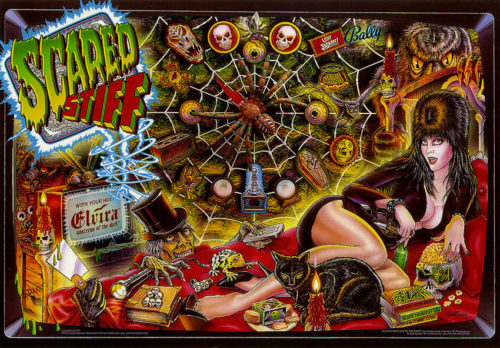 This macabre machine was also one of the most risque games ever made. The vocals are very suggestive as well as the theme of the game. The factory installed a family mode version to the game as well as a cover to the large breasts presented by Elvira on the back glass. Designed by Dennis Nordman and Mark Weyna, the art package came out of the mind of Greg Freres. The object of the game is to complete the six modes represented on the bottom of the playfield. Once all six modes are complete, the object then is to shoot the jackpots with two balls in play all the way up the stiff-o-meter. Doing so produces a pinball fireworks show of light as well as the flippers activating by themselves. The hardest feature on the game is represented in the back glass. If you can achieve all lights by stopping the spider on each and every stop displayed, a special spider multiball is activated. Happy Halloween!
This macabre machine was also one of the most risque games ever made. The vocals are very suggestive as well as the theme of the game. The factory installed a family mode version to the game as well as a cover to the large breasts presented by Elvira on the back glass. Designed by Dennis Nordman and Mark Weyna, the art package came out of the mind of Greg Freres. The object of the game is to complete the six modes represented on the bottom of the playfield. Once all six modes are complete, the object then is to shoot the jackpots with two balls in play all the way up the stiff-o-meter. Doing so produces a pinball fireworks show of light as well as the flippers activating by themselves. The hardest feature on the game is represented in the back glass. If you can achieve all lights by stopping the spider on each and every stop displayed, a special spider multiball is activated. Happy Halloween! -
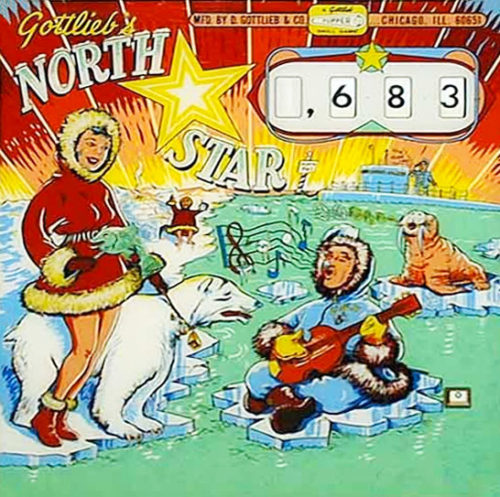
-
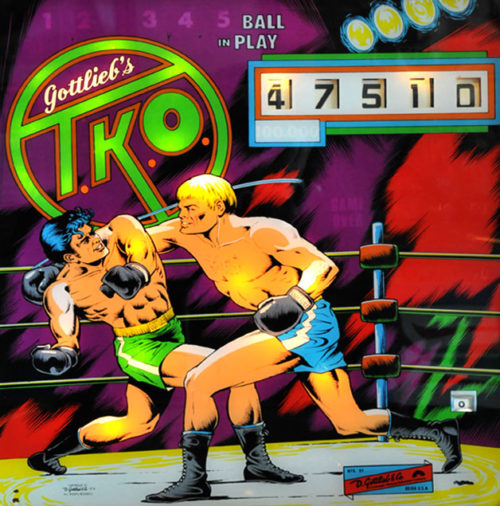 Look no further! If you’re searching for the rarest of the rare, here for your perusal is not one but two examples of this Gottlieb aberration. Supposedly only 125 were made of this game and most were sold overseas. Ed Krynski and Gordon Morison again teamed up to art and design the game. This game represents one of the last electromechanical “wedgehead” games ever built near the shores of Lake Michigan. It’s also a single-player game and one of the last. The object of the game is not really boxing in the true sense but hitting enough targets to advance the central advance display up to the top of the rack. This will ignite the special lights for a free game. The color-coordinated advance inserts on the play field correspond to the light-up features on the play field and, if you advance the light sequence accordingly, those features light up for the brief time the advance mechanism stays on that light. Score is the easiest way to win a replay.
Look no further! If you’re searching for the rarest of the rare, here for your perusal is not one but two examples of this Gottlieb aberration. Supposedly only 125 were made of this game and most were sold overseas. Ed Krynski and Gordon Morison again teamed up to art and design the game. This game represents one of the last electromechanical “wedgehead” games ever built near the shores of Lake Michigan. It’s also a single-player game and one of the last. The object of the game is not really boxing in the true sense but hitting enough targets to advance the central advance display up to the top of the rack. This will ignite the special lights for a free game. The color-coordinated advance inserts on the play field correspond to the light-up features on the play field and, if you advance the light sequence accordingly, those features light up for the brief time the advance mechanism stays on that light. Score is the easiest way to win a replay. -
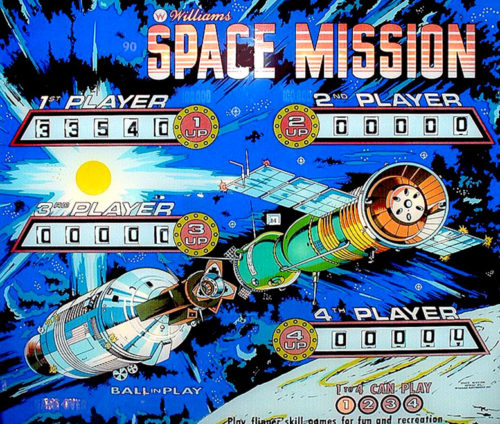 Space Mission was released in January, designed by Steve Kordek with artwork by Christian Marche. Production run was 11,652. This game was very successful for Williams and is considered to be the seventh most desirable game of the ’70s era.The game features a moving target as well as two side kickers next to the flippers for shots at the moving target. Making the A, B, or C light up the side eject holes to award a double bonus for the ball in play. If you were skillful enough to complete the A, B and C, the side outlanes light up for special. The top horshoe loop advances the bonus system. This game has a lot of nice shots and is fast paced. One doesn’t tire easily trying to achieve the scores needed to win a free game. This game was one of Steve’s Kordek’s favorite designs.
Space Mission was released in January, designed by Steve Kordek with artwork by Christian Marche. Production run was 11,652. This game was very successful for Williams and is considered to be the seventh most desirable game of the ’70s era.The game features a moving target as well as two side kickers next to the flippers for shots at the moving target. Making the A, B, or C light up the side eject holes to award a double bonus for the ball in play. If you were skillful enough to complete the A, B and C, the side outlanes light up for special. The top horshoe loop advances the bonus system. This game has a lot of nice shots and is fast paced. One doesn’t tire easily trying to achieve the scores needed to win a free game. This game was one of Steve’s Kordek’s favorite designs. -
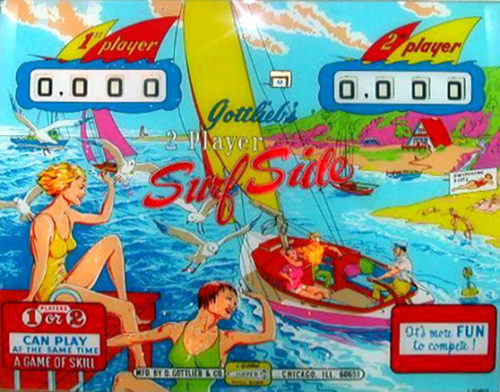 This pinball had a run of 1750 units. Designed by Ed Krynski with artwork by Art Stenholm, this 2 player four flipper game has no specials. The object of the game is to score a lot of points by advancing the yellow and red multipliers up to 100x where up to 500 points could be hit. Hitting the 100x level resets the hit column back to 1x. Extra balls are awarded if the roto spin target is hit when the star is in position. The use of the four flippers in the game makes one feels that the machine has two playfields in one. The new design pop bumpers, and auto ball lift are in early use here as well as the ball count meter. A challenging game that’s hard to beat!!!
This pinball had a run of 1750 units. Designed by Ed Krynski with artwork by Art Stenholm, this 2 player four flipper game has no specials. The object of the game is to score a lot of points by advancing the yellow and red multipliers up to 100x where up to 500 points could be hit. Hitting the 100x level resets the hit column back to 1x. Extra balls are awarded if the roto spin target is hit when the star is in position. The use of the four flippers in the game makes one feels that the machine has two playfields in one. The new design pop bumpers, and auto ball lift are in early use here as well as the ball count meter. A challenging game that’s hard to beat!!! -
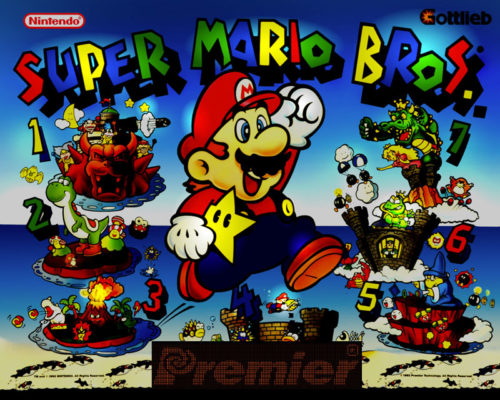 The player controls Mario throughout the Mushroom Kingdom. Mario’s abilities can be changed by picking up certain items; for example, Mario is able to shoot fireballs if he picks up a Fire Flower. The player takes on the role of the main protagonist of the series, Mario. Mario’s slightly younger brother, Luigi, is only playable by the second player in the game’s multiplayer mode, and assumes the same plot role as Mario. The objective is to race through the Mushroom Kingdom, survive the main antagonist Bowser?s forces and save Princess Toadstool. The player moves from the left side of the screen to the right side in order to reach the flag pole at the end of each level. A prevalent rumor that it is possible to jump over the flag pole was later confirmed by GameTrailers. The game world has coins scattered around it for Mario to collect, and special bricks marked with a question mark (“?”), which when hit from below by Mario, may reveal more coins or a special item. Other “secret” (often invisible) bricks may contain more coins or rare items. If the player gains a red and yellow Super Mushroom, Mario grows to double his size and can take one extra hit from most enemies and obstacles, in addition to being able to break bricks above him. Players are given a certain number of lives (and may gain additional lives by picking up green and orange ‘1-Up’ mushrooms, collecting 100 coins, or defeating several enemies in a row with a Koopa shell), which are lost when Mario takes too much damage, falls in a pit, or runs out of time; the game ends when all lives are lost. Mario’s primary attack is jumping on top of enemies, though many enemies have differing responses to this. For example, a Goomba will flatten and be defeated, while a Koopa Troopa will temporarily retract into its shell, allowing Mario to use it as a projectile. These shells may be deflected off a wall to destroy other enemies, though they can also bounce back against Mario, which will hurt or kill him. An alternate way to damage enemies is with the Fire Flower, an item which, when picked up, changes the color of Mario’s outfit (or only increases his size if a red and yellow mushroom had not been used previously) and allows him to shoot fireballs. A less common item is the Starman, which often appears from concealed or otherwise invisible blocks. This makes Mario temporarily invincible to most hazards and capable of defeating enemies on contact. The game consists of eight worlds with four sub-levels called “stages” in each world. The final stage of each world takes place in a castle where Bowser or one of his decoys are fought. The game also includes some stages taking place underwater, which contain different enemies. In addition, there are bonuses and secret areas in the game. Most secret areas contain more coins for Mario to collect, but others may contain “warp pipes” which allow Mario to advance to later worlds in the game, skipping over earlier ones.
The player controls Mario throughout the Mushroom Kingdom. Mario’s abilities can be changed by picking up certain items; for example, Mario is able to shoot fireballs if he picks up a Fire Flower. The player takes on the role of the main protagonist of the series, Mario. Mario’s slightly younger brother, Luigi, is only playable by the second player in the game’s multiplayer mode, and assumes the same plot role as Mario. The objective is to race through the Mushroom Kingdom, survive the main antagonist Bowser?s forces and save Princess Toadstool. The player moves from the left side of the screen to the right side in order to reach the flag pole at the end of each level. A prevalent rumor that it is possible to jump over the flag pole was later confirmed by GameTrailers. The game world has coins scattered around it for Mario to collect, and special bricks marked with a question mark (“?”), which when hit from below by Mario, may reveal more coins or a special item. Other “secret” (often invisible) bricks may contain more coins or rare items. If the player gains a red and yellow Super Mushroom, Mario grows to double his size and can take one extra hit from most enemies and obstacles, in addition to being able to break bricks above him. Players are given a certain number of lives (and may gain additional lives by picking up green and orange ‘1-Up’ mushrooms, collecting 100 coins, or defeating several enemies in a row with a Koopa shell), which are lost when Mario takes too much damage, falls in a pit, or runs out of time; the game ends when all lives are lost. Mario’s primary attack is jumping on top of enemies, though many enemies have differing responses to this. For example, a Goomba will flatten and be defeated, while a Koopa Troopa will temporarily retract into its shell, allowing Mario to use it as a projectile. These shells may be deflected off a wall to destroy other enemies, though they can also bounce back against Mario, which will hurt or kill him. An alternate way to damage enemies is with the Fire Flower, an item which, when picked up, changes the color of Mario’s outfit (or only increases his size if a red and yellow mushroom had not been used previously) and allows him to shoot fireballs. A less common item is the Starman, which often appears from concealed or otherwise invisible blocks. This makes Mario temporarily invincible to most hazards and capable of defeating enemies on contact. The game consists of eight worlds with four sub-levels called “stages” in each world. The final stage of each world takes place in a castle where Bowser or one of his decoys are fought. The game also includes some stages taking place underwater, which contain different enemies. In addition, there are bonuses and secret areas in the game. Most secret areas contain more coins for Mario to collect, but others may contain “warp pipes” which allow Mario to advance to later worlds in the game, skipping over earlier ones. -
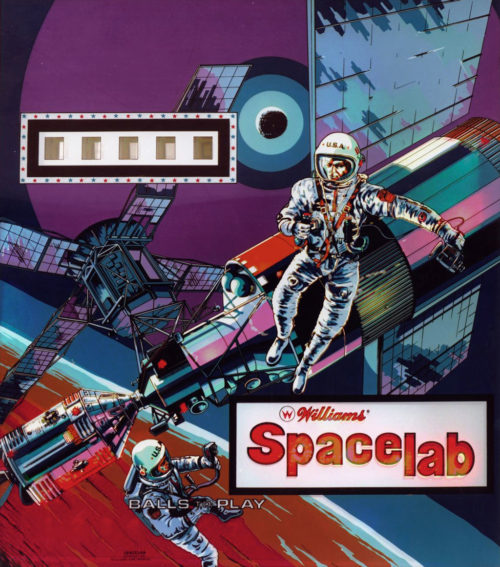
-
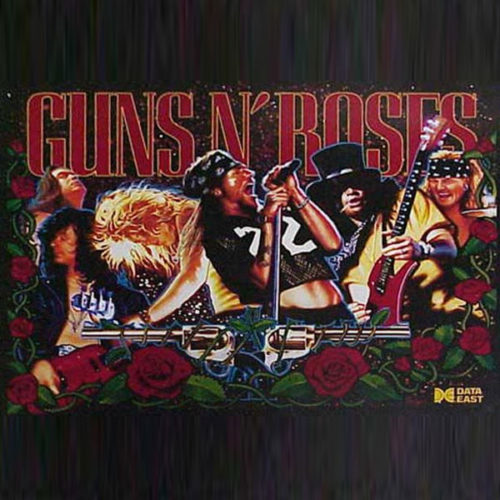
-
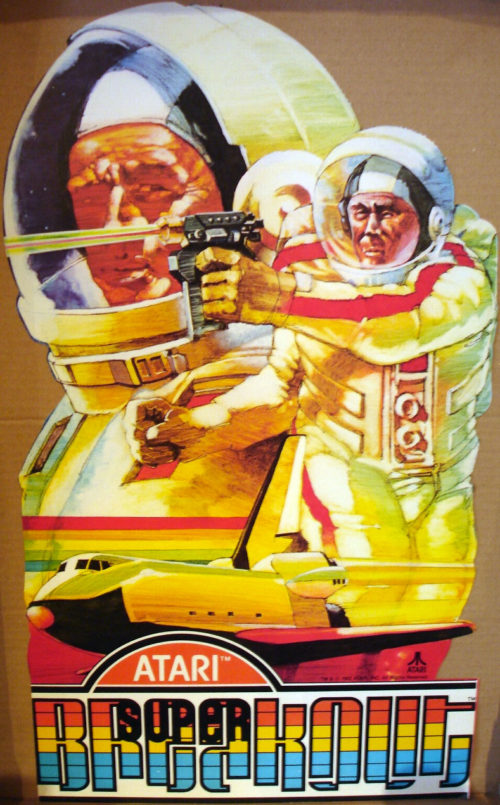 Move a paddle back and forth at the bottom of the screen to rebound a ball back into a brick wall, knocking bricks out one by one. There are three separate games: double — same as Breakout, knock down bricks and when they are all gone a new wall forms cavity — two other balls are inside the wall, when they have an escape route you can hit them as well progressive — as the wall is destroyed, new bricks are added and the entire wall shifts down toward your paddle. The sound effects are just simple beeps. This video game is a typical late ’70s machine which has been reproduced in many variations as well as downloaded apps on smartphones today. No complicated rules here, which is why it was so popular in its glory days. You control the horizontal paddle at the bottom of the playfield and, through the use of the spin controller, try to prevent losing the “ball” below the paddle. By aiming at the bricks, you try to hit all of them and then “break through” to the next layer of bricks. This accomplishment is rewarded with a period of high scoring and ricocheting video bounces of the “ball” until it escapes the brick layer and comes into your paddle again. These brick layers then start to drop toward your paddle. By the way, the TV is black and white!
Move a paddle back and forth at the bottom of the screen to rebound a ball back into a brick wall, knocking bricks out one by one. There are three separate games: double — same as Breakout, knock down bricks and when they are all gone a new wall forms cavity — two other balls are inside the wall, when they have an escape route you can hit them as well progressive — as the wall is destroyed, new bricks are added and the entire wall shifts down toward your paddle. The sound effects are just simple beeps. This video game is a typical late ’70s machine which has been reproduced in many variations as well as downloaded apps on smartphones today. No complicated rules here, which is why it was so popular in its glory days. You control the horizontal paddle at the bottom of the playfield and, through the use of the spin controller, try to prevent losing the “ball” below the paddle. By aiming at the bricks, you try to hit all of them and then “break through” to the next layer of bricks. This accomplishment is rewarded with a period of high scoring and ricocheting video bounces of the “ball” until it escapes the brick layer and comes into your paddle again. These brick layers then start to drop toward your paddle. By the way, the TV is black and white! -
 Gottlieb produced a few baseball-themed games, but Williams Manufacturing was the king of these types of games. This game, designed by Ed Krynski with art by Gordon Morison, had a run of 775 units. This is the add-a-ball version of this game, so it is rarer. The replay version is called Grand Slam. This game has eject holes which activate the roto-target, a Gottlieb exclusive device, which stops and a man is lit on a corresponding base to the eject hole on the baseball diamond. The rollover button lights when the bases are loaded. This scores 1,000 points whenever the bases are loaded. Runs and score are the ways to win free balls with this game.
Gottlieb produced a few baseball-themed games, but Williams Manufacturing was the king of these types of games. This game, designed by Ed Krynski with art by Gordon Morison, had a run of 775 units. This is the add-a-ball version of this game, so it is rarer. The replay version is called Grand Slam. This game has eject holes which activate the roto-target, a Gottlieb exclusive device, which stops and a man is lit on a corresponding base to the eject hole on the baseball diamond. The rollover button lights when the bases are loaded. This scores 1,000 points whenever the bases are loaded. Runs and score are the ways to win free balls with this game. -
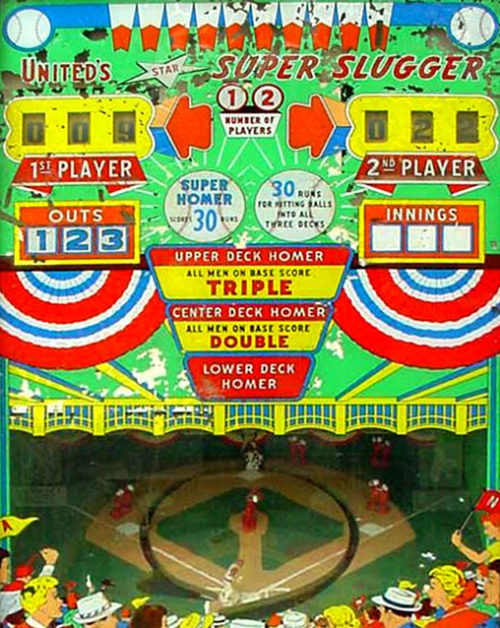 This massive baseball “pitch and bat” game is considered one of the best baseball games of its era. One or two players could play this behemoth at once, with each player alternating for three innings of play for a nickel or dime. The pitcher may randomly press one of three pitch buttons to pick a weak-to-strong pitch to the batter. The open play field allows one to try and score a home run in one of three bleachers. If you can achieve getting a homer in all three bleachers during your three outs, 30 extra runs are awarded. Then, of course, the ultimate tag of the ball would land the ball in the super home run hole, a rare achievement. This would also award 30 extra runs. Another unique feature of United baseball machines is the scoring of three singles if the ball drops in front of the ramps. These games are also notorious for having a slew of “out” holes. Batter up!
This massive baseball “pitch and bat” game is considered one of the best baseball games of its era. One or two players could play this behemoth at once, with each player alternating for three innings of play for a nickel or dime. The pitcher may randomly press one of three pitch buttons to pick a weak-to-strong pitch to the batter. The open play field allows one to try and score a home run in one of three bleachers. If you can achieve getting a homer in all three bleachers during your three outs, 30 extra runs are awarded. Then, of course, the ultimate tag of the ball would land the ball in the super home run hole, a rare achievement. This would also award 30 extra runs. Another unique feature of United baseball machines is the scoring of three singles if the ball drops in front of the ramps. These games are also notorious for having a slew of “out” holes. Batter up! -
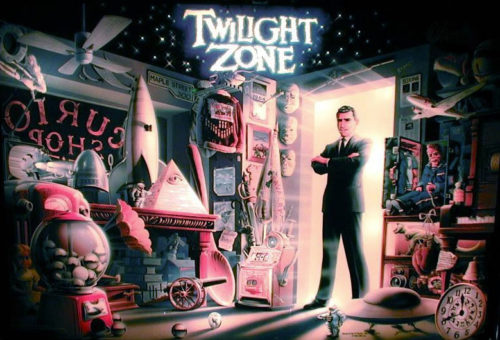 This game is the most complicated solid-state pinball machine for complexity and gadgetry ever made. 15,235 of these were made and design credits go to Pat Lawlor with art by John Youssi. Multiple multi-ball options, magnets, a porcelain power ball a gumball machine and an extra-wide play field are only part of what’s before you. The main object of the game is to complete all the segments of the door in the bottom of the play field. These segments illuminate a light in the door. If by rare chance you complete the feat (you can “buy in” extra balls at the end of your game), all heck breaks loose in the form of a “lost in the zone” ultimate stage in the game. All six balls pop out, every option special, and bonus is lit all at once, and then, as if by magic, the flippers stop working (as this is a timed event) and your bonus is totaled. The battle in the zone magnet-controlled play field and power ball are neat!
This game is the most complicated solid-state pinball machine for complexity and gadgetry ever made. 15,235 of these were made and design credits go to Pat Lawlor with art by John Youssi. Multiple multi-ball options, magnets, a porcelain power ball a gumball machine and an extra-wide play field are only part of what’s before you. The main object of the game is to complete all the segments of the door in the bottom of the play field. These segments illuminate a light in the door. If by rare chance you complete the feat (you can “buy in” extra balls at the end of your game), all heck breaks loose in the form of a “lost in the zone” ultimate stage in the game. All six balls pop out, every option special, and bonus is lit all at once, and then, as if by magic, the flippers stop working (as this is a timed event) and your bonus is totaled. The battle in the zone magnet-controlled play field and power ball are neat!